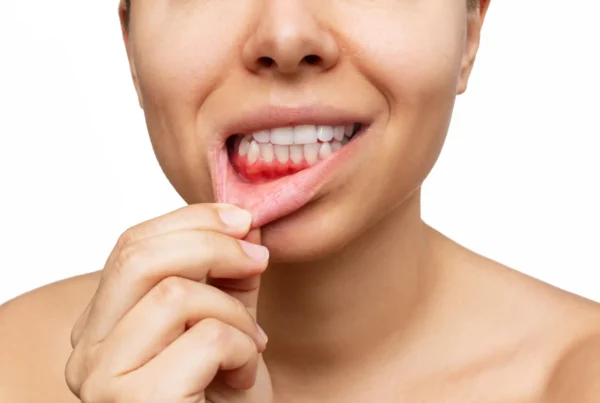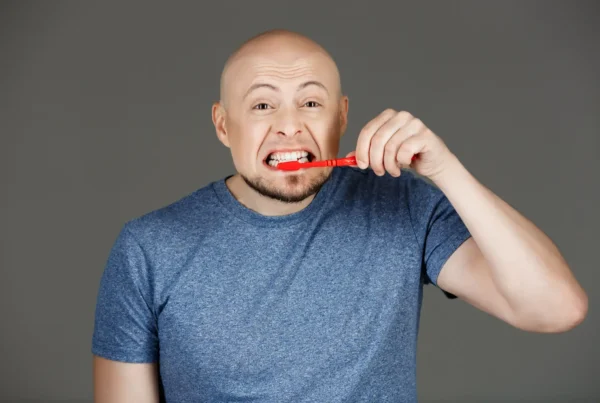- Tooth gangrene – what is it and what does it look like?
- Tooth gangrene – causes. How does it form?
- Total vs. partial tooth gangrene – what is the difference?
- Tooth gangrene – symptoms
- Tooth gangrene – how is root canal treatment performed?
- Tooth extraction as a method of treating gangrene
- Antibiotic therapy in the treatment of tooth gangrene
- Tooth gangrene – potential consequences and complications
- Tooth gangrene – dental X-ray
- Home remedies for gangrenous tooth pain – how to soothe it?
- Tooth gangrene – prevention
Tooth gangrene is a condition that, in its later stages, can be associated with persistent pain. It often develops as a result of untreated tooth decay, which penetrates deep into the enamel and dentin. Proper oral hygiene plays a key role in maintaining healthy teeth and gums, especially when it comes to preventing gangrene. But what exactly is tooth gangrene, and what are its causes and symptoms? How should you care for your oral cavity to prevent this condition? Keep reading to find out.
Tooth gangrene – what is it and what does it look like?
Tooth gangrene is another term for inflammation of the dental pulp, also known as pulpitis. The pulp is a connective tissue located in the pulp chamber and root canals. It is highly innervated, which is why inflammation in this area causes intense pain. What does gangrene involve? In this case, putrefactive decomposition occurs in the tissues, caused by anaerobic bacteria along with ammonia and sulfur compounds that trigger changes in the tissue. The pulp loses its original color and consistency, becoming a brownish, almost liquid substance with an unpleasant odor. Gangrene can also develop on the skin, in the lungs, or intestines. It can be either total or partial. Total gangrene affects the entire pulp, including the root canals, while partial gangrene develops in a specific area of the tooth.
Tooth gangrene – causes. How does it form?
The main cause of tooth gangrene is the action of anaerobic bacteria, which contribute to the gradual death of the pulp and the formation of harmful protein by-products such as ammonia or hydrogen sulfide. These bacteria are also responsible for the necrotic and putrefactive processes in the pulp.
Therefore, it can be concluded that improper oral hygiene leads to pulp inflammation. It is important not only to brush teeth regularly but also to use dental floss, mouthwash, and maintain tongue hygiene. Diet also plays a significant role. A high intake of carbohydrates can accelerate the development of tooth decay.
Total vs. partial tooth gangrene – what is the difference?
Total tooth gangrene occurs when both the coronal and root chambers filled with pulp are affected. On the other hand, partial tooth gangrene refers to a condition where only specific root canals are affected. This is more common in multi-rooted teeth such as molars, which can have up to four roots.
Read also: Biting Your Lips
Tooth gangrene – symptoms
Keep in mind that tooth gangrene does not always cause pain, and it may initially develop without any noticeable symptoms. The specific symptoms depend on the type of pulpitis. Common symptoms of tooth gangrene include:
- Discoloration of the tooth
- Deep cavities reaching the pulp
- Tooth sensitivity to heat
- Unpleasant odor from the mouth
- Mild nighttime toothache
- Dullness or discoloration of the enamel
- Radiolucency in the periapical tissue area
Tooth gangrene – how is root canal treatment performed?
Pulp gangrene is usually treated endodontically, also known as root canal therapy. This involves opening the pulp chamber, cleaning it thoroughly, and filling it with a special dental material. If the putrefactive processes have reached the apical area of the root, surgical treatment may be necessary to remove the affected tissue.
Tooth extraction as a method of treating gangrene
Another, more radical method of treating dental gangrene is tooth extraction. When is extraction necessary? This happens when endodontic treatment is no longer possible due to extensive necrosis affecting too many tissues.
Antibiotic therapy in the treatment of tooth gangrene
Treatment of tooth gangrene can also involve taking oral medications prescribed by a specialist. Antibiotics reduce the risk of bacterial growth, while painkillers, as the name suggests, help relieve discomfort.
Tooth gangrene – potential consequences and complications
If tooth decay is not treated promptly, the bacteria causing gangrene can enter the bloodstream. This may lead to complications such as myocarditis, nephritis, or sepsis. There is also a risk of developing periapical abscesses in the bone and surrounding soft tissues.
Tooth gangrene – dental X-ray
Taking a dental X-ray is necessary to confirm the presence of gangrene and assess the overall condition of the teeth. This step is usually preceded by a detailed medical interview. In cases of advanced pulpitis, root canal treatment is typically required.
Home remedies for gangrenous tooth pain – how to soothe it?
Are there any home remedies for gangrenous tooth pain? Home treatment is limited to taking painkillers, applying cold compresses to the cheek near the affected tooth, or rinsing the mouth with a solution of salt or hydrogen peroxide. Rinsing with cold water may also offer brief relief, although the effect is very short-lived.
Tooth gangrene – prevention
To prevent tooth gangrene, it is essential to maintain good oral hygiene, follow a healthy diet, and visit the dentist regularly. Brush your teeth at least twice a day for two minutes, rinse your mouth with a special oral rinse, and use dental floss or an irrigator. Eliminate simple carbohydrates from your diet, especially sweets.






